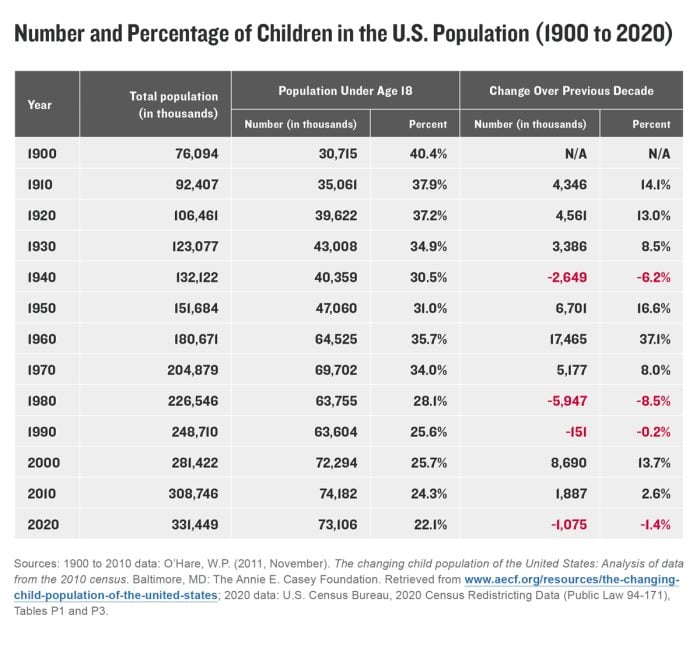City-Level Changes
Collectively, the number of children living in the 100 largest cities by child population decreased from 14.2 million in 2010 to 13.9 million in 2020 (a drop of 311,300 kids or 2.2%).

The United States is a wonderfully diverse nation, and its child population represents a kaleidoscope of races and nationalities. For all children to thrive, the basic needs of every young person — from every demographic group — must be met.
This child population report matters because it provides valuable information on demographic changes, such as the declining number of children and its implications for the labor force and education sector. Policymakers can use this information to make informed decisions on investing in children's education to ensure that the nation has enough skilled workers to keep the economy going strong. The report also highlights the disparities in educational outcomes for children of color, emphasizing the need for investment in all children to maximize their employability. Additionally, the report explores the relationship between child population growth and child outcomes, providing insights for policymakers on the best strategies to improve child well-being.
Changes in the population of children in the U.S. affect the demand for social services that are critical for families, such as schools and healthcare. Research indicators suggest that by the year 2050, the child population will not only increase significantly, but also shift demographically. It’s critical that policymakers understand and prepare for these changes — as they shape programs and policies of the future.

This report — released by the Annie E. Casey Foundation — compares 2020 census results to historical child population data. It explores how the U.S. child population is decreasing in size, increasing in diversity and changing substantially at the state and city levels.
Among the changes highlighted in the publication:
In August 2021, the U.S. Census Bureau released its 2020 census redistricting data files. These files provide detailed racial and Hispanic origin data for the nation’s total population and adult population. Child population data (representing the years from birth to age 17) was calculated by subtracting the relevant adult population count from the total population count.
It is notable that, since the mid-1960s, children have consistently comprised a smaller proportion of the U.S. population. As the Baby Boom came to an end in 1964, children made up 36% of the population. By contrast, in 2022, children only accounted for 22%. States vary significantly in the proportion of the population made up by children. Utah boasts the highest percentage of people under the age of 18 (population reference bureau) (29%), while Maine and Vermont had the lowest at 18.5% and 18.3%, respectively.
However, despite the historical decline, the population of children in the U.S. is projected to grow significantly in the coming decades. Just as important, the child population in the U.S. is expected to show substantial shifts in demographics. For example, in keeping with national trends, the percentage of children in most racial and ethnic groups has declined in recent years. However, the percentage of children who are Hispanic has grown dramatically since 1980, when they accounted for 9% of all U.S. children. In 2022, the share of U.S. children who are Hispanic ballooned to 26%. By the year 2023, less than half of all U.S. children will be white. Further, according to Child Stats, by 2050, 39% the U.S. child population will be white, 31% will be Hispanic, 14% will be Black, 7% will be Asian, and 9% will be "all other races."
It is critical that policymakers have a deep understanding of the shifts in the U.S. child population, as such shifts directly impact the demand for schools, healthcare, and other social services. Further, changing demographic and socioeconomic indicators must help shape the policies and social programs that are meant to serve communities and families. Demographic trends should inform how decision makers distribute resources and deliver services to their communities. For states with large Hispanic populations, for example — like California, Florida, and Texas — schools will likely need to expand cultural and language competencies. Certainly, as the U.S. child population becomes more diverse, data collection and analysis will remain crucial to ensuring that kids and families have the resources they need to thrive.
The previous version of this report — The Changing Child Population: An Analysis of the U.S. Population Under 18 Using Data From the 2010 Census — is still available.
Additional related resources:
One of the biggest stories from the 2020 census is the growing racial and ethnic diversity of children in the United States. Today, children of color represent a 53% majority share of the US child population, and more children than ever before identify as multiracial, non-Hispanic white. Because population trends have strongly influenced the social, economic and demographic fabric of the United States, the shifting child population represents challenges as well as opportunities for policymakers.
For example, a decrease in children means a future decrease in the labor market. This, in turn, marks an increase in the importance of kids’ educational outcomes so that they can become viable workers, creating a greater need for funding education. Learn about this and more in the report.